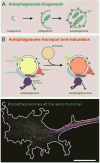Axonal autophagy: Mini-review for autophagy in the CNS
- PMID: 29548988
- PMCID: PMC6136980
- DOI: 10.1016/j.neulet.2018.03.025
Axonal autophagy: Mini-review for autophagy in the CNS
Abstract
Neurons are long-lived and highly polarized cells that depend on autophagy to maintain cellular homeostasis. The robust, constitutive biogenesis of autophagosomes in the distal axon occurs via a conserved pathway that is required to maintain functional synapses and prevent axon degeneration. Autophagosomes are formed de novo at the axon terminal in a stepwise assembly process, engulfing mitochondrial fragments, aggregated proteins, and bulk cytosol in what appears to be a nonselective uptake mechanism. Following formation, autophagosomes fuse with late endosomes/lysosomes and then are rapidly and efficiently transported along the axon toward the soma, driven by the microtubule motor cytoplasmic dynein. Motile autophagosomes mature to autolysosomes in transit by fusing with additional late endosomes/lysosomes, arriving at the soma as fully competent degradative organelles. Misregulation of neuronal autophagy leads to axonal degeneration and synaptic destabilization, and has been implicated in neurodegenerative diseases including Alzheimer's disease, Parkinson's disease, Huntington's disease, and ALS.
Keywords: Autophagosome biogenesis; Axon degeneration; Macroautophagy; Mitophagy; Neuronal homeostasis.
Copyright © 2018 Elsevier B.V. All rights reserved.
Figures

Similar articles
-
Regulation of neuronal autophagy and the implications in neurodegenerative diseases.Neurobiol Dis. 2022 Jan;162:105582. doi: 10.1016/j.nbd.2021.105582. Epub 2021 Dec 7. Neurobiol Dis. 2022. PMID: 34890791 Free PMC article. Review.
-
Axonal autophagosomes use the ride-on service for retrograde transport toward the soma.Autophagy. 2015;11(8):1434-6. doi: 10.1080/15548627.2015.1062203. Autophagy. 2015. PMID: 26102591 Free PMC article.
-
The axonal endolysosomal and autophagic systems.J Neurochem. 2021 Aug;158(3):589-602. doi: 10.1111/jnc.15287. Epub 2021 Jan 15. J Neurochem. 2021. PMID: 33372296 Review.
-
Understanding amphisomes.Biochem J. 2021 May 28;478(10):1959-1976. doi: 10.1042/BCJ20200917. Biochem J. 2021. PMID: 34047789 Free PMC article. Review.
-
Neuronal autophagy and axon degeneration.Cell Mol Life Sci. 2018 Jul;75(13):2389-2406. doi: 10.1007/s00018-018-2812-1. Epub 2018 Apr 19. Cell Mol Life Sci. 2018. PMID: 29675785 Free PMC article. Review.
Cited by
-
Early defects in mucopolysaccharidosis type IIIC disrupt excitatory synaptic transmission.JCI Insight. 2021 Aug 9;6(15):e142073. doi: 10.1172/jci.insight.142073. JCI Insight. 2021. PMID: 34156977 Free PMC article.
-
Ap4b1-knockout mouse model of hereditary spastic paraplegia type 47 displays motor dysfunction, aberrant brain morphology and ATG9A mislocalization.Brain Commun. 2023 Jan 6;5(1):fcac335. doi: 10.1093/braincomms/fcac335. eCollection 2023. Brain Commun. 2023. PMID: 36632189 Free PMC article.
-
Going Too Far Is the Same as Falling Short†: Kinesin-3 Family Members in Hereditary Spastic Paraplegia.Front Cell Neurosci. 2019 Sep 26;13:419. doi: 10.3389/fncel.2019.00419. eCollection 2019. Front Cell Neurosci. 2019. PMID: 31616253 Free PMC article. Review.
-
Potential mechanisms underlying lithium treatment for Alzheimer's disease and COVID-19.Eur Rev Med Pharmacol Sci. 2022 Mar;26(6):2201-2214. doi: 10.26355/eurrev_202203_28369. Eur Rev Med Pharmacol Sci. 2022. PMID: 35363371 Free PMC article. Review.
-
Antiaging Mechanism of Natural Compounds: Effects on Autophagy and Oxidative Stress.Molecules. 2022 Jul 8;27(14):4396. doi: 10.3390/molecules27144396. Molecules. 2022. PMID: 35889266 Free PMC article. Review.
References
Publication types
MeSH terms
Grants and funding
LinkOut - more resources
Full Text Sources
Other Literature Sources
Miscellaneous

